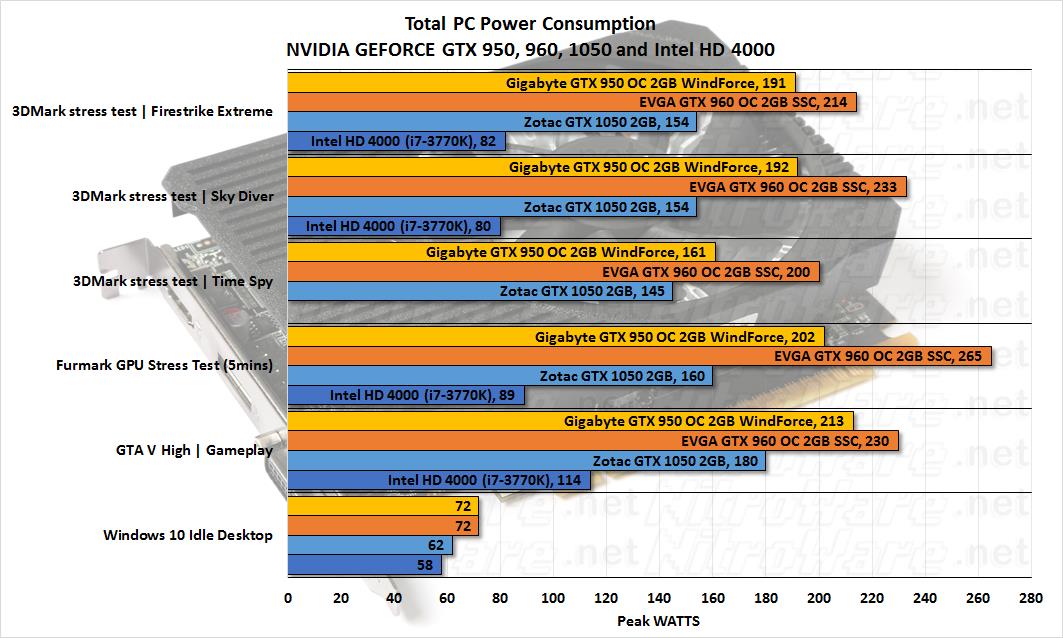GTX 1050 - Power Consumption
I use several metrics to gauge power consumption, using a wall AC power meter for total system power consumption. Other publications measure the GPU only. By comparing with the integrated graphics (and the PC needs a video out to function), the additional power consumption of the add-in graphics card can be determined.
3DMark now includes several stress test modes which loop a 60-second portion of its benchmarks for the purpose of stability checking with a default of 20 passes. I do not use all 20 passes and take the peak power measurement once the figures have stabilised on the meter.
| 3DMark Stress Test | Target Hardware | Engine | Render Resolution |
|---|---|---|---|
| Time Spy | High performance Win10 Gaming PC | DirectX 12 Feature level 11 | 2560x1440 |
| Fire Strike Extreme | Multi-GPU Systems and overclocked PCs | DirectX 11 Feature level 11 | 2560x1440 |
| Sky Diver | Gaming laptops and Mid range PCs | DirectX 11 Feature level 11 | 1920x1080 |
We can consistently see the Pascal GP107 Powered GTX 1050 uses 15 to 40 watts less than its Maxwell based 950/960 siblings. Remember this test is not as a benchmark. All it is doing is rendering the same scene in a loop.
Furmark is an OpenGL test that is considered a 'power virus' ie will max out a graphics card's power consumption to its absolute limit and is not what is used to determine typical power consumption. We can see the differences in the power systems of the cards under test, with our big and heavy 960 using a custom power supply design as well as a single 8 pin power connector versus the simpler 950 with its 6 pin power and even simpler 1050 with bus power only. Again, 40 watts difference. Wonderful!
Yes I made sure that during the Furmark test which was run for five minutes, all cards were at their maximum power levels.
So we have DirectX 12,11 and OpenGL synthetic tests but what about real world gaming?
To measure this I took GTA V and actively played the game while watching the power meter. For our benchmarks instead I used the benchmark mode as a stable reference, but gameplay can vary and let's face it that’s the numbers we want.
The gameplay section is just after Franklin and Lamar deliver their cars to Simeon where free-roam is first unlocked. Driving through the streets of Los Santos and up the Coastal highways with varying graphical scenery and lighting as typical play is.
Again, 30 watts delta between our 75 watts 1050 and 90 watts 950. I threw in Intel HD 4000 which did run GTA V at the high setting I test at but it was somewhat a slideshow. The Integrated Graphics consumed 114W but the 1050 GPU consumed 180 Watts. The integrated graphics uses about 19 watts so if we subtract that from 114 we get the approx 75 Watts 1050 is rated at, with overhead/margin of error. So the card is actually consuming what it is advertised as 75 Watts Typical Board Power.
At the Idle windows 10 desktop with no open applications we see a 10 Watt drop in idle power draw between Maxwell and Pascal. This is thanks to the smaller manufacturing process (14nm v 28nm) plus a lower operating voltage. Maxwell cards typically IDLE at 0.8 Volts while Pascal at 0.6 V. Load voltages range from 0.9570 volts for GTX 1050 under Furmark load to 1.212 V for GTX 960 under the same Furmark load
1050 still consumes 4 watts more than the Intel IGP just drawing an idle screen but that could be down to simple things such as the GPU cooling fan which on this model does not stop below 60c or the efficiency of the GPU's on-board power supply.

All these tests confirm GTX 1050 and Pascal uses less power to achieve the same results as the older Maxwell GPUs. and our earlier benchmarks show that the performance is close enough that the lower power consumption is not result of lower performance.